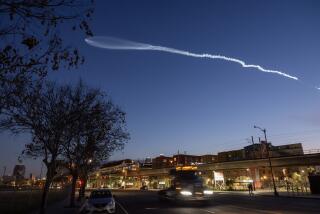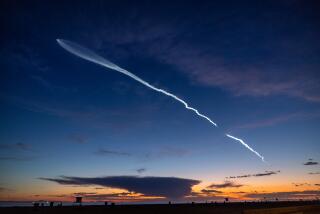Planning Goes Forward for Spaceport in Australia
- Share via
SYDNEY — Australia believes that it is ideally placed to build the world’s only commercial space rocket base.
Promoters of the “spaceport,” planned for a vast wasteland on the northern Cape York peninsula, say the first satellite launching pad in the South Pacific could underpin Australian economic prosperity in the 21st Century.
“This spaceport presents Australia with a similar opportunity to that provided by sheep 200 years ago--it uses the country’s natural advantages to the full,” said Peter David, marketing coordinator for the Cape York project.
The base would initially use multiple launch pads to send up satellites on expendable rockets. But in the long term the spaceport is seen as the Pacific “terminus” for a new generation of reusable spacecraft--and for space travelers.
The reusable spacecraft could fly passengers from Australia to Europe in three hours.
“These are long-term goals, there will be no short-term profit. Australia seems in the mood to take this kind of long-term thinking seriously,” said John Simmons, chairman of the National Committee on Space Engineering.
Agency officials think there is a vacuum in the commercial launch business which Cape York is ideally suited to fill.
The 1986 Challenger disaster forced a reappraisal of the space shuttle and rekindled interest in expendable commercial launch vehicles in the United States. When NASA subsequently withdrew from the business, several countries active in the industry were left looking for another base for their operations.
David has addressed packed business meetings in Australia to drum up support for the fledgling project.
The Queensland state government chose a Brisbane-based company, Cape York Space Agency Pty Ltd., to undertake an 18-month feasibility study on the spaceport.
However, the Queensland government insisted that the CYSA call on the resources of the six other bidders to prevent them from being recruited for rival projects.
If the study shows the project to be economically viable, agency co-director Bill Head said, it would be another two or three years before the company could launch its first rocket after spending $1 billion.
The advantages offered by the peninsula are proximity to the equator, excellent weather, good air and sea links, and low population on the flight paths. The agency says the advantages offered to the Australian economy are even bigger. These include Jobs from construction of the spaceport, transfer of technology from the satellite business to Australian firms, establishment of service industries and the regeneration of northern Queensland.
“The commercial space business in Australia could have the same effect as the semi-conductor industry in California over the last 20 years,” says David.
The claims may sound large, but experts agree that Cape York offers satellite owners advantages over most other launch sites, including proposed bases in Kiribati, Hawaii and Indonesia.
Australia is a politically neutral country with a stable democratic system. It has good internal and external communications and is close to the fast-evolving Asian market.
The site is 12 degrees south of the equator, and equatorial orbits are most commonly used for satellites. The less fuel needed to position a satellite, the larger a rocket’s payload can be.
“Fuel is the important element, not just in the rocket but in the satellite itself. If the satellite can carry more fuel and thus stay in orbit for two more years, it’s worth millions of dollars,” said engineer Simmons.
The base’s remote location means the noise and danger of falling debris will inconvenience few, although the agency is at pains to stress the importance of enviromental protection.
More to Read
Sign up for Essential California
The most important California stories and recommendations in your inbox every morning.
You may occasionally receive promotional content from the Los Angeles Times.










